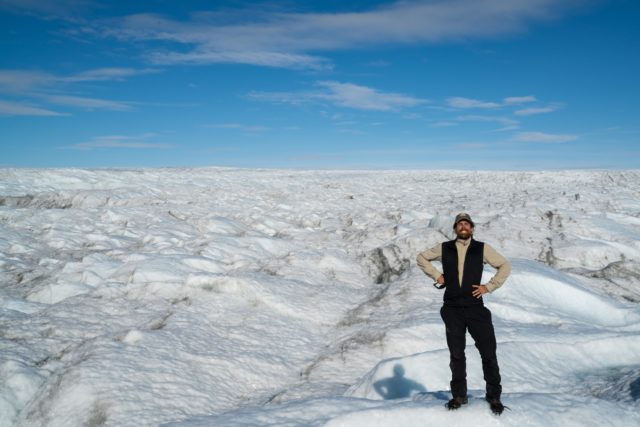
Chris Dunn stood on the edge of a melting glacier on the icy shores of Greenland, the wind whipping his face while frostbite-inducing currents raced in the gaping fjords beneath him. The philosopher and environmental researcher felt a wide range of emotions about the journey that led him to this remote spot.
“I would call [Greenland] the loneliest, wildest place I’ve ever been,” Dunn says. “It felt so isolating, and there was a background fear the whole time. Like, ‘Gosh, I can’t wait till this ends,’ but also, ‘What’s just around the corner?’ It’s this complex mixture of wonder and fear and accomplishment.”
When Dunn returned to Boulder, he sought a way to translate these intangible emotions into a work that would convey his feelings toward this landscape in a very real way for others—a tall order, given the challenge of trying to fully immerse someone in a place that’s not only unfamiliar to them, but entirely otherworldly.
For Dunn, the presentation, produced by CU Boulder’s Nature, Environment, Science & Technology Studio for the Arts, was about creating a “direct, embodied sensation” for others—in other words, crafting a space that would allow them to see the vast peaks and valleys surrounding these glaciers, hear the cracking and straining of melting ice sheets, and parse through scientific documents that further enhance understanding of these glaciers’ size, scope and current conditions in an ever-warming climate.
This is the meat and bones of Dunn’s Sensing Ice, Explorations Of Knowing Nature, a multimedia exhibit currently displayed at CU Boulder’s Earth and Map Science Library. Alongside photographs and scientific measurements collected by Dunn, the exhibit features on-site music and recordings from Alaskan composer Matthew Burtner. These elements, according to Dunn, combine to create a primarily artistic and philosophical experience, rather than one geared toward educating about climate science. Establishing a strong sense of place was a key component of this project, an inspirational model Dunn drew from Henry David Thoreau’s Walden, which weaves environmentalism and philosophy.
“What I’m trying to do is create a place for humanities research and perspectives within these places that are completely dominated by the sciences almost entirely,” Dunn says.

Sensing Ice: Explorations of Knowing Nature. The Jerry Crail Johnson Earth Sciences & Map Library, 2200 Colorado Ave., Boulder. Through Dec. 29.
For Dunn, this was the crux of his academic foundation, as he completed a master’s in philosophy from the University of Montana before moving to Boulder to pursue a doctorate in environmental studies, a program he completed in late 2021. Throughout his years researching and working as everything from a backcountry ranger to a freelance photographer, Dunn made a striking realization.
“The world needs more humanities research alongside scientific research,” he says, especially “in places that are often exclusively visited and researched by scientists.”
Dunn’s journey in Greenland and the resulting product of Sensing Ice seeks to get at the heart of this issue, where, in this day and age of polarizing climate rhetoric, pressing ideas are often conveyed through inaccessible reports or flat-out misinformation, rather than artistic works that appeal to people’s emotions in a positive way.
“Obviously, scientists, especially field scientists, go to places, and they are attentive to those places, but in a very different way,” Dunn says. “They’re already going in with a sense of how they’re going to approach the world. Essentially, they’re going to measure certain things, or observe certain things systematically, or they have certain hypotheses in mind already. But there’s something that happens once you leave the field and you write up what you did. It really strips away all the experience of a sensation. And that place is kind of lost altogether.”
Thus, Dunn’s work seeks to create a new world, one in which “humanities aren’t just in service of the sciences.” Throughout Sensing Ice, emphasis is given first to the pure sights, sounds and emotions evoked by witnessing these primordial sheets of ice, rather than bogging down an audience in facts they may already know.
“I’m not trying to preach to the choir,” Dunn admits, alluding to Boulder’s progressive population that Dunn trusts with preexisting familiarity and involvement with climate activism.
So, Sensing Ice wasn’t crafted as a product of pure science communication, much less science activism. However, Dunn recognizes that exhibiting a work of art related to melting glaciers in 2022 is sure to garner the easy assumption that it is.
“Any art can move beyond the intent of the creator, and that’s perfectly fine,” Dunn says. Plus, he knows that creating a project as immersive as this one has purpose beyond evoking raw, philosophical emotion. For Dunn, putting these massive, immovable natural landscapes on display may offer a fresh perspective for those looking to fully grasp the impact the anthropocene era may have on these remote locations, no matter how much we assure ourselves these icy monuments can stand the test of time.
“To solve really complex problems, especially environmental issues, you need to be looking at it in a variety of ways,” Dunn says. “I really do think that this approach is a big, important piece that needs to be part of the (climate) conversation because I do think it actually can and should affect real world decisions.”
“It is pretty cool, though, when on an isolated ridge in what feels like the middle of nowhere, to wonder if anyone has set foot there, but never knowing for sure,” Dunn adds, reflecting back on that icy cliff-side thousands of miles from home. “What is significant is that the landscape itself is left in such a condition that it isn’t evident. I think that we need to continue to keep some places that way.”
***
Email: [email protected]














